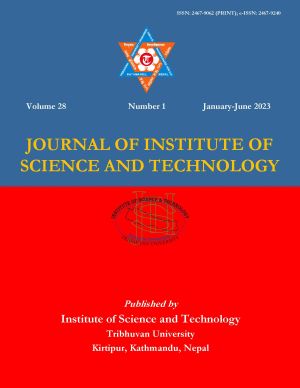Evaluation of Disturbance Zonation of Bagmati River System using Benthic Macroinvertebrates in the Kathmandu Valley, Nepal
DOI:
https://doi.org/10.3126/jist.v28i1.49979Keywords:
Bagmati River system, benthic macroinvertebrates, GRSBIOS/ASPT, Kathmandu Valley, river water qualityAbstract
The existence of Nepal's holy river, Bagmati, which flows through the core of Kathmandu Valley has been menaced by many anthropogenic threats. It is necessary to identify how vulnerable it has been. This research focuses on the evaluation of disturbance zonation to analyze the Bagmati River System’s spatial biological health. Benthic macroinvertebrates (BMIs) were used as biological indicators and were sampled from upstream to downstream using a multi-habitat sampling approach during the post-monsoon period in 2021. The Ganga River System Biotic Score/Average Score per Taxa (GRSBIOS/ASPT) was used to assess river water quality. From the sampling of 21 sites, a total of 5839 individual BMIs from 51 Families and 11 Orders were recorded. Upstream accounted for more than 30% of all the families, making upstream rich in taxonomic preferences, which steadily decreased from midstream to downstream. Facultative taxa were widely distributed in both upstream and midstream, but sensitive taxa were limited to upstream only. There are no signs that facultative and sensitive taxa existed downstream and were fully dominated by pollution-tolerant species. According to classification, the upstream river within Shivapuri Nagarjun National Park of the Bagmati River System was clean and was categorized as Class I, whereas rivers from the boundaries of the protected area to downstream were categorized as Class IV-V with few sites as Class II and Class III, indicating that this stretch of the river was extremely polluted. Water resource managers should utilize the study's findings to assess and restore the water's quality using biological indicators.
Downloads
Downloads
Published
How to Cite
Issue
Section
License
Copyright (c) 2023 Institute of Science and Technology, T.U.

This work is licensed under a Creative Commons Attribution-ShareAlike 4.0 International License.
The views and interpretations in this journal are those of the author(s). They are not attributable to the Institute of Science and Technology, T.U. and do not imply the expression of any opinion concerning the legal status of any country, territory, city, area of its authorities, or concerning the delimitation of its frontiers of boundaries.
The copyright of the articles is held by the Institute of Science and Technology, T.U.




